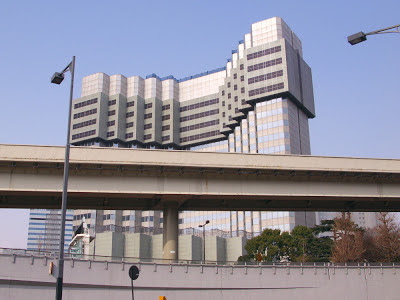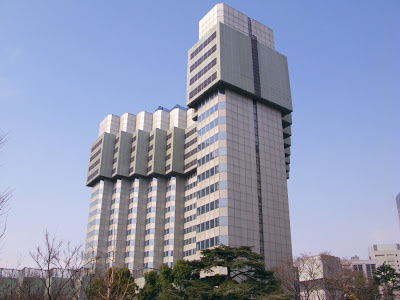Shrinking Hotel in Akasaka Tokyo
赤坂プリンスホテル
Overlooking Tokyo's business and entertainment district of Akasaka is what was once a grand hotel on a hill, the Grand Prince Hotel Akasaka (known as the Akasaka Prince Hotel until 2007).
The hotel itself dates from 1955, and the current 40-story building dates from 1983. The height of it combined with its chic, glassy, V-profile and how it overlooked the Aaksaka-mitsuke district together with the nearby Hotel New Otani, made the Grand Prince a playground of the rich and famous during Japan's Bubble Era of the 1980s.
It is perhaps fitting then that this former pillar of extravagance is now shrinking. Yes, a shrinking building! I didn't get it myself when the Grand Prince Hotel Akasaka's noticeably shortened stature first caught my eye a few months ago. I put it down to faulty memory, perception, or a mixture of the two, but learned just a few days later that my faculties had, in fact, served me properly and that the Grand Prince Hotel Akasaka was gradually growing smaller.
The 138.9 meter (455 foot) tall hotel closed at the end of March 2011. From April to June it was used to house refugees from the Great East Japan Earthquake. Then in June 2012, demolition of the Grand Prince Hotel Akasaka got underway.
However, this happened to be the tallest building in Japan ever to be a target of demolition. The height of the building combined with its proximity to numerous surrounding buildings made traditional methods of demolition problematic.
Firstly, installing cranes at that height was, reportedly, considered a problem (one which is a little difficult to understand, however, considering how commonly cranes are installed at enormous heights for construction purposes), the concern about noise, dust and danger vis-a-vis the rest of the neighborhood was also a big problem.
So the solution was to use the roof of the building as a cover, as a huge, perfectly fitting "hat" and encasing the building in a sheath, inside of which the demolition work was carried out, and which was lowered little by little following the demolition of each floor.
Dreamed by up by the construction company, Taisei Corporation, this unique demolition method is dubbed the Taisei Ecological Reproduction System, or "Tecorep," the "ecological reproduction" bit referring to its parallels to (i.e. "reproduction of") the natural process of decomposition.
Besides obviating the need for cranes, Tecorep makes it possible to keep demolition going 24/7, without the constraints of potential neighborhood complaints about noise and dust, or bad weather.
The photos here were taken just this week and show that the Grand Prince Hotel Akasaka has reached about half its former height. The demolition schedule was delayed from the very beginning, so when it will finish is anyone's guess, but considering how long it has taken to get this far, it might not completely disappear until the end of this year.
© JapanVisitor.com
Inside Track Japan For Kindle let's you enjoy the most memorable posts from the JapanVisitor Blog on your Kindle. Buy now!
Tags
Japan
Tokyo
Akasaka
hotel
demolition
Subscribe to:
Post Comments (Atom)




No comments:
Post a Comment